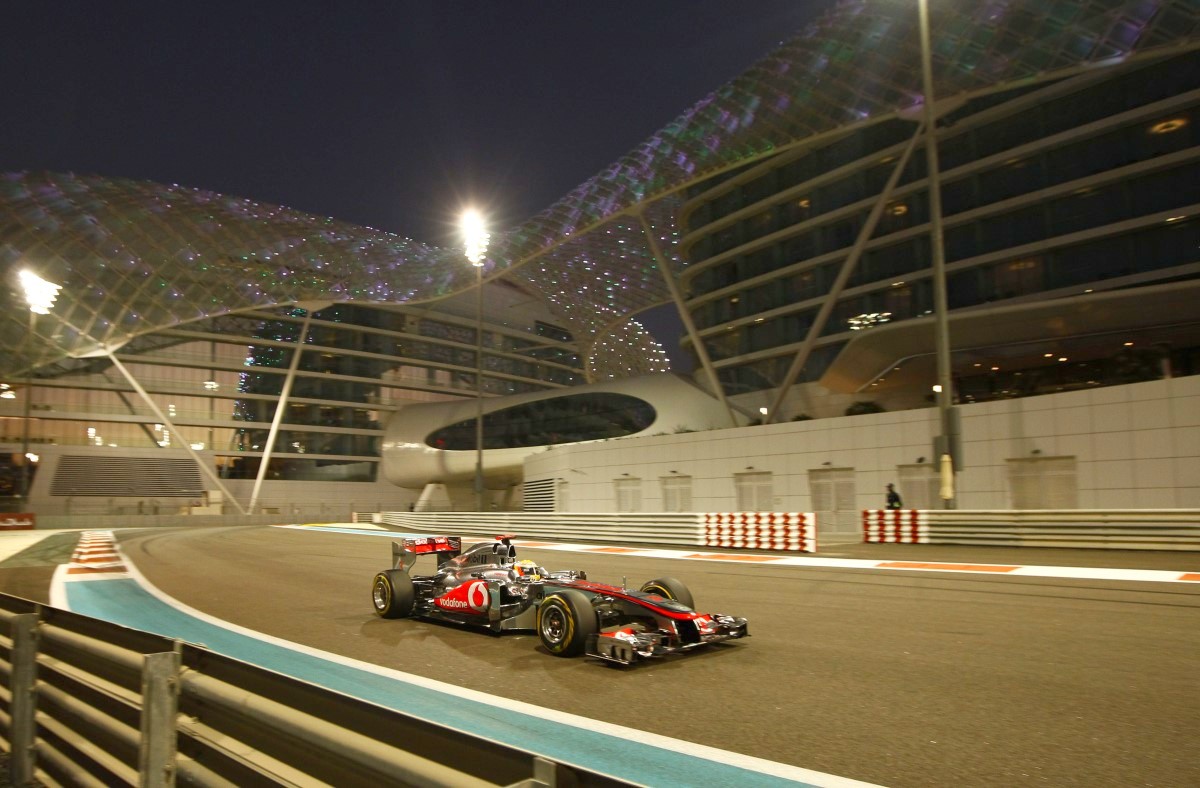Abu Dhabi F1 preview
 |
| The lights come on for the Abu Dhabi GP |
Formula One probably peaked in terms of race venue design with the Yas Marina Circuit, one of the first elements of a massive US$40 billion development of manmade Yas Island and undoubtedly the most technologically advanced and spectacular Grand Prix venue of all.
Woven around a manmade port and the visually stunning Yas Hotel, the exterior of which changes color on demand and provides stunning imagery during a Grand Prix, the circuit itself may not quite live up to the surroundings, but Abu Dhabi has undoubtedly made a statement with its purpose-built Formula One venue.
“It’s a top three Formula One event now along with Singapore and Monaco in my opinion," says Jim Wright. Mark Gallagher adds: “It’s a delightful event. Infrastructure is perfect, the hotels are fantastic."
Where once Yas Marina Circuit stood alone on a deserted island, some 20 minutes or so from the heart of Abu Dhabi, it is increasingly surrounded by hotels, restaurants and other leisure facilities such as the Yas Links golf course. The Ferrari World theme park has become a particularly distinctive feature, sitting alongside the circuit. The overall Yas Island project is a fundamental part of Plan Abu Dhabi 20130, which was launched in 2007 by the Abu Dhabi Urban Planning Council as the strategy for the emirate to become a hub for tourism and business.
 |
| The sun sets on the 2012 Abu Dhabi GP |
The Abu Dhabi Grand Prix, run at 5pm local time with the start taking place at sunset and the end of the race under floodlights, has been a major corporate success. “It’s normally sold out, very strong," says Jim Wright. “There’s great warmth towards the event from the local community and business, great awareness of the event because they do a very good job of promoting it and they’re also smart enough to combine racing with entertainment."
Mark Gallagher adds: “It’s a great event to visit. The market itself is not a huge one but for international companies who will have an EMEA region Abu Dhabi is a very appealing event for that Middle East/Africa market to bring people and to run consumer marketing programs.
“It really is a super event and it is the reason, long-term, why Bahrain might ultimately struggle. It’s always been questionable whether the Gulf region can sustain two events."
While the circuit and event is funded by the government as part of its strategy to use Formula One to promote Abu Dhabi, the man tasked with running Yas Marina Circuit day to day is Irishman Richard Cregan, a former Toyota Formula One team manager who has more than a little motorsport knowledge to impart.
The circuit hosted its first Formula One race in 2009 and, as well as the annual Grand Prix, has become home to an annual young drivers test as well as a variety of other motorsport and community events. Cregan, speaking in 2011, told SportsPro magazine that now the 50,000-capacity circuit has bedded in, day-to-day maintenance is the challenge. “It’s a permanent venue so it’s quite different to a lot of Formula One circuits in the sense that all the grandstands are permanent and require a lot of maintenance, purely because of the harsh conditions of the environment: you have high humidity in the summer and that in itself means you have to have a lot of maintenance. It’s a continuous process.
“The other thing that is happening is our landscaping is maturing nicely. We invest a lot of time and effort to make sure it’s very, very presentable." The Black Book
Yas Marina is one of those tracks that require a neutral engine set-up. There are long straights but equally some tight, slow corners so the engine needs to be strong in all conditions rather than tailored to one particular parameter.
The external factors of the track need careful consideration. Similar to India, the concentration of dust or grit in the atmosphere means we need to monitor the air filters and clean where necessary to avoid blockages. This is especially important when you take the high ambient temperatures into account. During the day we can see the ambient temperature rise to well over 30°C so cooling is critical – if the air ingested is reduced by just a fraction of a percentage it could well have an adverse effect on the engine cooling.
Another important factor to consider is the fuel consumption, which is one of the highest of the year per lap. The circuit is by nature very demanding on the consumption, particularly the stop-start of the final sector. The consumption rate is increased further by the sea level altitude, but an aspect we need to monitor is the changing temperatures between sessions. During the day when the temperatures are higher the fuel consumption is lower, but during the night sessions it increases. This nuance will be factored in for the race to avoid finishing with too much or too little fuel.
Notwithstanding these challenges, we are looking forward to this race. Even though the constructors’ and drivers’ championships are now secured there is everything to play for behind, and we would love to be able to help Lotus get second position in both. For Williams and Caterham there are still three more opportunities to get points on the board. To do this we’ll keep focused and pushing right until Brazil.
